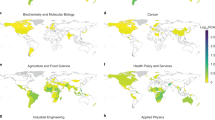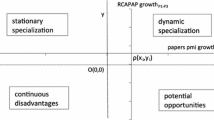Abstract
The goal of this article is to show that it is possible to construct an index to measure a country's relative specialization in different scientific fields in a way which is both reliable and relevant for macro-strategic analysis. We will call this index a “Revealed Scientific Advantages Index”. The technical problem to be discussed is one of aggregation: how can we be sure that an index calculated for a small number of relatively large fields does not mask significant policy needs synthetic measures which are easy to interpret. We will show that the “Revealed Scientific Advantages” approach offers the possibility of building them. The study itself is based on figures obtained through an exploitation of the INIST/CNRS PASCAL database classification of science. 107 sub-fields of this classification were initially used to determine the areas of specialization for 11 countries (“revealed national advantages”). Clustering techniques were then used to aggregate this data and 13 specific fields were identified. The science policy information produced during the study concerned these 13 fields. It proved to be both easily understandable and relevant for macro-strategic analysis.
Similar content being viewed by others
Notes and references
I would like to thankJ.P. Courtial and K. Pavitt for their helpful comments on earlier versions of this article.
J. Irvine, B. Martin,Foresight in Science: Picking the Winners, Francis Pinter, London, 1984, Chapter 2.
R. Barré “Science and Technology Policy in France: From planning to strategy,Futures 18(2)(April 1987) 298–307.
T. Braun, W. Glänzel, A. Schubert,Scientometric Indicators: A 32 Country Comparative Evaluation of Publishing Performance and Citation Impact, World Scientific Publishing Company, Singapore and Philadelphia, 1985.
A.F.J. Van Raan (Ed.),Handbook of Quantitative Studies of Science and Technology, Elsevier, Amsterdam, 1988.
We borrow this expression fromP. Patel andK. Pavitt, who use it for technology (“Revealed Technology Advantage”). See, for example,P. Patel, K. Pavitt, Is Western Europe losing the technological race?,Research Policy 16(1987) 59–85. They in turn took the expression from the term “Revealed Comparative Advantage” used in the analysis of international exchanges.
The CHI-Research database, for example, gives 107 sub-field categories.
The information was extracted from the PASCAL database under the direction of MmeD. Pelissier from INIST. Its analysis was carried out byM.J.P. Bordet from the company ASSI.
This is called an ascending hierarchical classification.M. Jambu, M.O. Lebeaux,Classification Automatique pour l'Analyse des Données t. 1. Méthodes et Algorithmes t.2 Logiciels, Dunod, Paris, 1978.
See alsoJ.M. Bouroche, G. Sapurta,L'Analyse des Données Presses Universitaires de France, Paris, 1980.
For an analysis covering France the United Kingdom, West Germany, the United States and Japan, seeR. Barré, A strategic assessment of the scientific performance of five countries,Science and Technology Studies, 5(1987) 32–38.
Author information
Authors and Affiliations
Rights and permissions
About this article
Cite this article
Barré, R. Clustering research fields for macro-strategic analysis: A comparative specialization approach. Scientometrics 22, 95–112 (1991). https://doi.org/10.1007/BF02019277
Received:
Issue Date:
DOI: https://doi.org/10.1007/BF02019277




